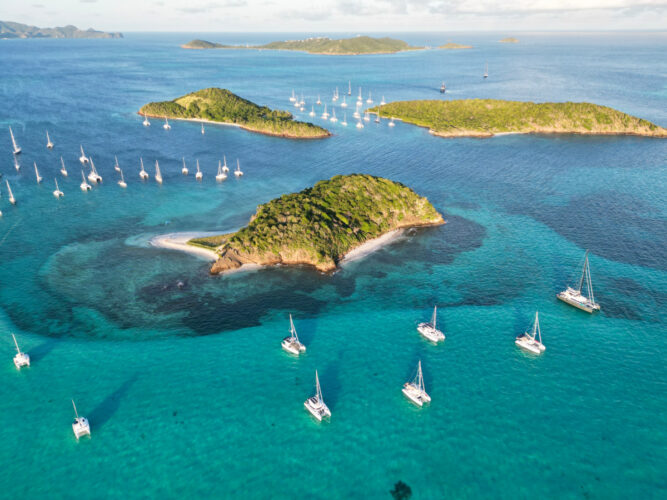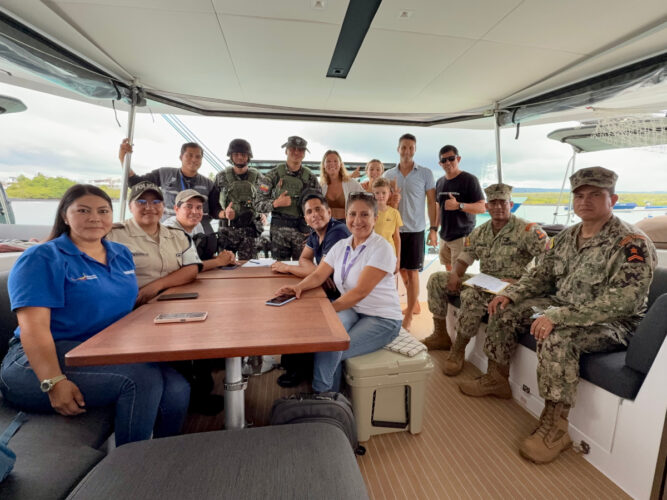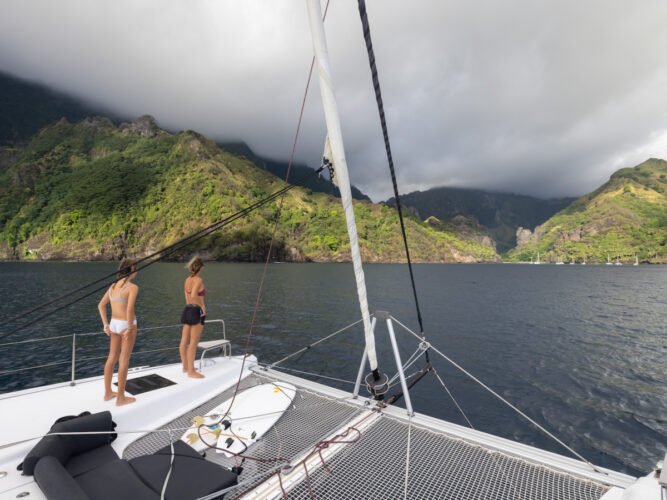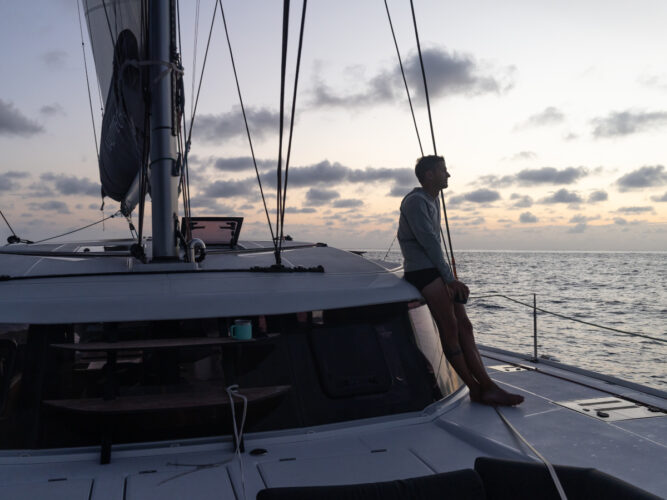In Part 1 of this article, Natalie shared valuable advice – and entertaining stories – about navigating immigration and customs procedures as she and her family travel the world by boat aboard June. The following is a continuation of that excellent discussion, sharing the knowledge gained over 2.5 years and 23 countries.
Caribbean Cruising: Equal Parts Personable and Unpredictable
Leaving our colourful mainland European departure experience behind, we enjoyed a brisk sail to the Canary Islands, and eventually across the vast Atlantic Ocean on our first major ocean crossing.
Sailing through the Caribbean, we encountered a vibrant mix of cultures and check-in procedures. Many islands use the SailClear app to streamline paperwork, though technical hiccups often necessitate filling out forms by hand. In contrast to the uniformity and reliability of Schengen Zone immigration processes, our Caribbean experience varied wildly. On more than one occasion, we checked into a country only to discover that although personnel were on hand, the stamp for our paperwork was located in another office, requiring us to return the following day. On at least one occasion, immigration officials ran out of printer ink, and we had to wait an extra day while they procured more ink.
Despite these quirks, the warmth and friendliness of immigration officials made each stop memorable. In Jamaica, for example, a jovial committee of inspectors joined us for a friendly beer after our brief check-in, transforming formality into a social event. On various Caribbean islands, immigration officers posed for selfies at the helm and on the bow of our boat, or exchanged personal contact information, offering to guide us to local attractions on their days off. Overall, immigration officers across the Caribbean were friendly and welcoming, and we cherished both their relaxed cheer and the occasional unexpected hiccup that made our experiences memorable.

At anchor on the very edge of the reef at Tobago Cays – it feels like looking out over the edge of the world.
Exploring the Galapagos: A Unique Check-in Experience
Some parts of the world are so precious that regulations for visiting cruisers are remarkably strict – and for good reason. The Galapagos Islands, renowned for their unique biodiversity, implement specific procedures and regulations designed to protect their fragile ecosystem.
Cruisers wishing to visit the Galapagos must present several essential documents, including a certificate of professional hull cleaning, a fumigation certificate, and a transiting permit. Additionally, it is necessary to secure mooring permits for each of the four designated anchorages accessible to outside visitors, as well as refueling permits and other pertinent documentation.
While the use of an agent may seem unnecessary in many parts of the world, and we would agree that it is, the Galapagos’ stringent entry requirements make having a local agent here invaluable. Their services can vary in cost and scope, ranging from basic assistance to comprehensive support, but they universally facilitate a smoother entry process to these special islands.

Clearing into Galápagos – officials gathered in June’s cockpit.
We had a fantastic experience with our Galapagos agent, who provided exceptional information and service. He went above and beyond by connecting us with a reliable boat minder when we left for a nine-day excursion, and even arranged for a friend experiencing a dental emergency to receive urgent treatment from a local dentist.
Despite the considerable costs associated with visiting the Galapagos, including the added expense of hiring an agent, the unforgettable encounters with the islands’ wildlife and rich local culture made every moment worthwhile. Snorkeling with playful sea lions, walking among nesting birds, and learning about the islands’ unique natural history are experiences that our family will treasure for a lifetime.
Managing Long-Term Visas: French Polynesia as a Common Long-Term Stop

First glimpses of the wild and dramatic volcanic peaks of the Marquesas after weeks at sea was an emotional moment.
For many cruisers planning an east-to-west Pacific crossing, acquiring a long-stay visa for French Polynesia is a common and strategic choice. Many boat insurance policies don’t allow cruisers to continue west beyond a given longitude until the South Pacific cyclone season has passed.
Long-term visas typically need to be arranged well in advance of your intended visit. We applied for our visas at the French Embassy in Panama, which required a lengthy two-month process. The paperwork was extensive, necessitating financial documentation as well as formal proof that our children’s education met Canadian curriculum standards.
It’s crucial to note that long-stay visas cannot be obtained once cruisers have already arrived in French Polynesia. It is therefore essential to plan ahead and apply for extended-stay visas a good time before your arrival if there is a possibility that you will visit long enough to require one.

Finding little paradises along the way – like this pink-sand islet in Fakarava, Tuamotus.
Pets and Passports: The Added Complexities of Cruising with Animals
Pet owners face additional challenges with the immigration process and must present vaccination certificates and other paperwork in various countries. Our children once researched pet entry requirements for each country we planned to visit, hoping to persuade us to adopt a kitten onboard – a dream that, much to their dismay, never materialized.
Sailors with pets should pay close attention to specific requirements, especially when planning Pacific crossings toward destinations like French Polynesia, the South Pacific Islands, New Zealand, and Australia. It’s crucial to research these requirements and restrictions in advance.
A friend meticulously planned their Pacific crossing to New Zealand around their family dog, necessitating a stop in Tahiti in French Polynesia (the only location in the long island chain that can clear onboard pets) before sailing 600 nautical miles upwind back to the Marquesas and Tuamotus in order to cruise that area. The dog was also required to spend six consecutive months in one country before entering New Zealand. The rest of the family flew ahead to New Zealand while our friend waited in French Polynesia with the dog. While onboard pets make great companions, they can certainly complicate your voyage!
Smooth Sailing with Visitors and Crew
Welcoming friends, family, or crew members aboard can enhance your cruising experience, but it can also complicate the immigration process – especially when crossing international borders. By planning ahead and communicating clearly with your visitors, you can ensure a smooth experience.
We created a formal letter for our visitors, confirming their status as temporary crew members, specifying their duration on board, and noting our entry and exit points, as well as any other specific requirements for each destination. Regulations can vary by country, so it is important to investigate this in advance. Guests found the letter helpful during the immigration process and it was an added reassurance to have on hand.

Left: Exploring reefs as vibrant as the world above; Right: Sonnen feeling perfectly at home in this life on the water.
Summary: Key Tips for a Smooth Immigration Process
- Keep a binder ready with essential documents photocopied. Include passports, boat registration, boat insurance, vaccination certificates, and travel health insurance documents. Note that copies of boat insurance documents and individual medical insurance or immunization records are sometimes requested during check-in.
- Have a printer onboard to print out any necessary application paperwork or supporting documents.
- Join regional WhatsApp groups for up-to-date information from fellow sailors; they are fantastic sources of insight into current immigration processes.
- Before arriving, fly both the country’s flag and the Q flag to indicate you haven’t checked in. Ensure you have flags on hand for all the countries you will be visiting.
- Use resources like Noonsite and NoForeignLand for local immigration information.
- Research whether the Captain or full crew is required for check-in and check-out, which usually involves visiting an immigration office or having officials come to your boat.
- Have USD and/or Euros available, as application fees require payment in these currencies in many countries. Do not assume that you will be able to use a credit card for these payments.
- Allow yourself plenty of time; the process can take longer than expected and may be affected by staffing shortages, weekends, or public holidays.
Charting Your Course: Embracing the Journey Ahead
Crossing borders by sea can be unpredictable – but with preparation and patience, it becomes just another part of the adventure. We’ve had tense nights, warm welcomes, and everything in-between. We hope our experiences offer some guidance and inspiration as you prepare to chart your own course.

A quiet sunrise coffee on the bow – the kind of ritual that grounds life at sea.
Thank you for joining us on this leg of our travels! We invite you to follow our ongoing adventures as we continue to navigate the seas.
Wishing you fair winds!
You can follow The Hunt Family’s journey on Instagram @sailing_june or reach out to them directly by email for any follow-up questions.








Hi Natalie
Your articles were both extremely informative and very entertaining. Thank you for sharing your thoughts. It was a pleasure to read them and everything you said resonated with me and our experiences.
All the best
Cathy
SV Pixie
Thanks so much for the kind words Cathy! Fantastic to have had mentors like the two of you to help us on feet! Love that this sailing community is always there to support each other in all of the big and small ways.
Hello Natalie, Peter, Remy, and Sonnen
I’m thrilled to read of your ongoing adventures and see you passing on your experience to other dreamers!
Enjoy the best of Fiji!
Cheers
Wow – what a great article, Natalie! Wonderful help for anyone planning to cruise anywhere! The ‘bureaucracies of cruising’ have changed a great deal since we sailed to Galapagos and west over 20 years ago but you’ve highlighted the beauty of places you’ve visited as well as the friendliness of officials and local people – both of which help make offshore cruising the truly magical experience it is.
Best wishes for your cruising adventures to come!